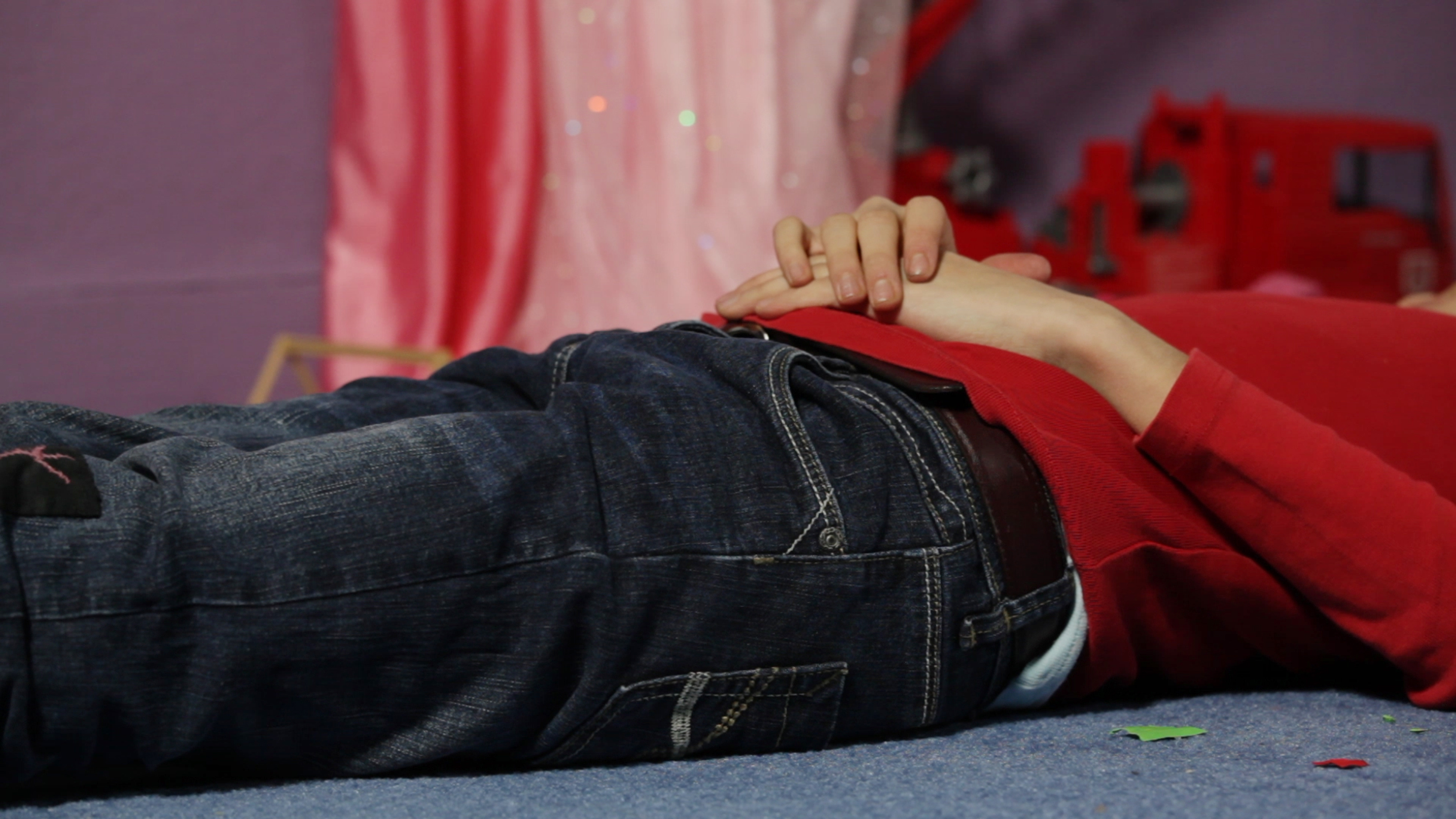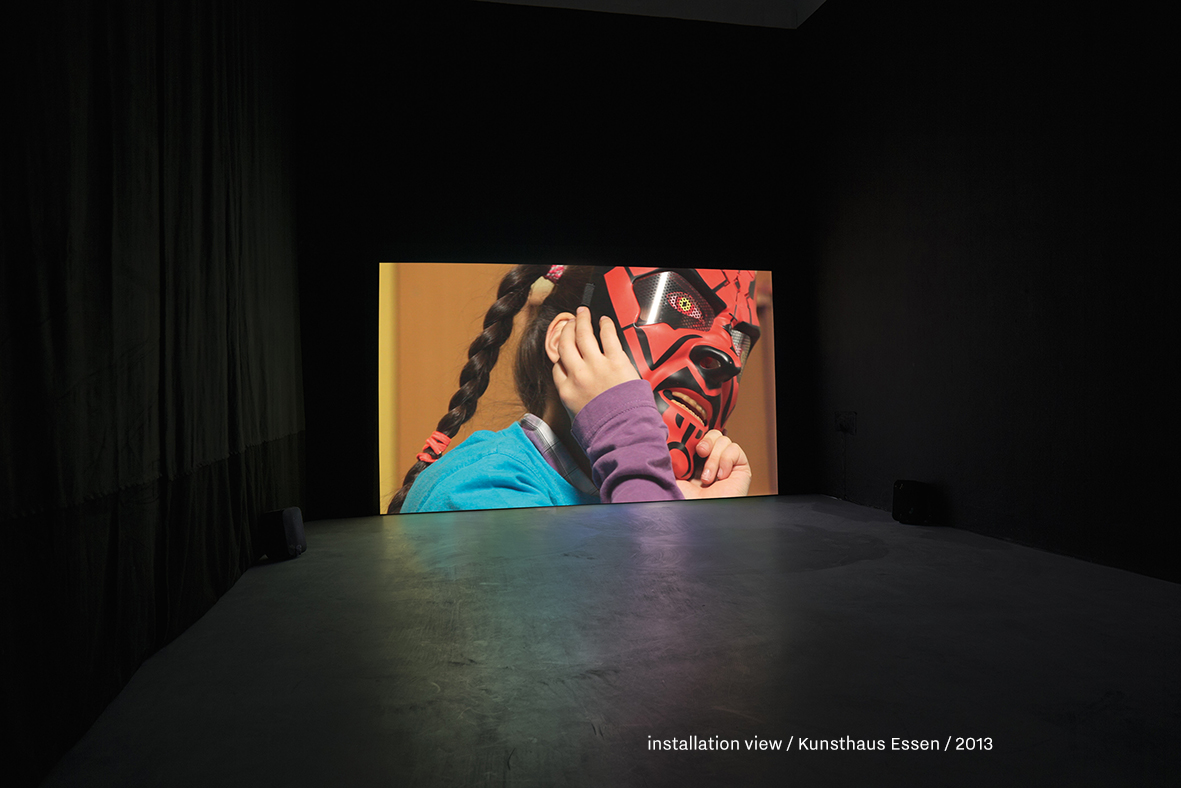Setting
2013 / video installation (projection) / loop / HD / 16:9 / sound / 05:00 min
The work "Setting" (2013), deals with girls around the age of six. What makes this film special is that its ambiguity is made transparent. A girl builds a golden tower with chocolate coins that are scattered around. Another puts so much candy in her mouth that she almost cannot manage to swallow it. (...) A skull that looks more like a shrunken head appears along with a pair of pale, crippled, bizarre looking witch hands. The shutters of a colorfully painted walk-in cardboard house open up and play-money comes flying out. The floor is already covered with bills. (...) A girl wears a devil mask. When she pushes a button, a rough male voice can be heard. A little pony stands on another shelf along with a model of a black luxury car.
The ambiguity of this film conveys our experience of today through the viewpoint of a child: abundance, pouring money down the drain, unnecessary craving and consumption of food, the ecstasy of ideal beauty, the domino effect that is caused by rapidly progressing debt, the artificiality of the everyday world, social isolation, luxury and evil. (...) The girls’ childlike impetus is acting of its own accord and a scenario is described that one day may be catching up with them. This is only one aspect though. The other, which is central, shows how adults, though they may mean well, infiltrate the minds of children by purposefully giving them toys. It is needless to say that the artist manipulates and stages the girls, but at the same time she consciously exposes the manipulation. On the one hand, ambiguity becomes evident, on the other hand, the artist reveals herself: she herself exemplifies – pars pro toto – a subversive process that infiltrates the consciousness (the manipulation of the girls) and which proves to be an efficient illusion. (...)
(excerpt catalogue text, by Jean-Christophe Ammann)
Die Arbeit „Setting“ handelt von etwa sechsjährigen Mädchen. Das besondere an diesem Film besteht darin, dass die Doppelbödigkeit transparent wird. Aus herumliegenden Schokoladentalern baut ein Mädchen einen goldenen Turm; eines wirft sich aus einer Tüte so viele Süßigkeiten in den Mund, dass es diese schier nicht bewältigen kann (…) ein Totenkopf, eher ein Schrumpfkopf, skurrile, blass-verkrüppelte Hexenhände sind zu sehen; die Fensterläden in einem begehbaren, farbig bemalten Häuschen aus Pappe öffnen sich, heraus fliegen Spielgeldscheine, von denen schon etliche den Boden bedecken (…) das Mädchen trägt eine Teufelsmaske, betätigt es die Sprechtaste, ist eine kratzende Männerstimme zu hören; in einem Regal steht ein Plastikpony, daneben das Modell einer schwarzen Luxuslimousine.
Die Doppelbödigkeit enthält, was wir heute erleben, aus der Sicht eines Kindes: den Überfluss – buchstäblich das Geld aus dem Fenster werfen; die Fresssucht; die Extase des Schönheitsideals; den durch rasante Verschuldung bewirkten Dominoeffekt; die Künstlichkeit von Welt; das Aussondern von Menschen; den Luxus und das Böse. Sie handeln in ihrem kindlichen Impetus gewissermaßen aus sich selbst heraus, ein Szenario beschreibend, das sie eines Tages einholen könnte. Jedoch ist dies nur der eine Aspekt. Der andere, zentrale, zeigt, wie Erwachsene die Sicht des Kindes infiltrieren, ihm die Utensilien des Spiels zielgerichtet und wohlmeinend in die Hände geben. Natürlich manipuliert und inszeniert die Künstlerin die Mädchen, aber sie entlarvt damit gleichzeitig die Manipulation. Es gibt zum einen die offensichtlich gemachte Doppelbödigkeit, zum anderen eine Handlung, in der sich die Künstlerin selbst enttarnt. Sie zeigt am eigenen Beispiel – pars pro toto – einen subversiven, das Bewusstsein unterwandern- den Prozess (die Manipulation der Mädchen), der glaubhaft macht, was sich als effizientes Trugbild herausstellt. (...)
(Ausschnitt Katalogtext, by Jean-Christophe Ammann)
excerpt:






